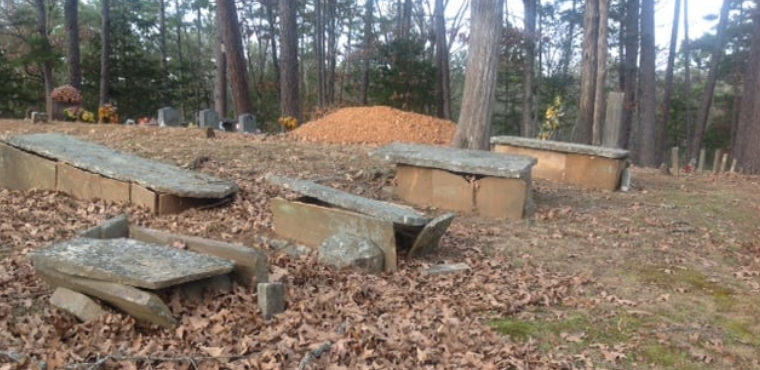By Dr. Curtis Varnell
Located at the top of the hill at Hickory Grove cemetery in Logan County is an unusual collection of grave stones. Composed of slabs of thick sandstone, the gravesite is completely covered in box-like containers of rock.
The rock boxes are found in few cemeteries in the U.S., most are in rural Tennessee, the Carolinas, and in the mountains of Arkansas. In our region, there are a few found north of Ozark, at Chismville, and in small family cemeteries.
As a child, I was told those were old burial sites from the Civil War. Men were off fighting in the war, the ground was rocky and hard, so women dug shallow graves and protected the bodies by covering them with stone. Seemed like a good explanation and one that appealed to my historical perception. Unfortunately, my science background kicked in and I realized the data just did not fit. Shaping and moving those rock would be more difficult than digging the graves. Additionally, the burial dates for the deceased did not match the dates of the civil war; in fact, James Hixson, a Civil War death has a typical stone and his grave is located just south of these stones.
If you research tent burials, you will find that they are very similar and found in the same area, the final product being a tent rather than a rectangle. Tent burials and stone rectangle burials have one thing in common; they are all found in mountain areas settled by the Scotch-Irish. Scotch-Irish traditions abound in our region because they were the primary settlers of the region and migrated here from Tennessee and the Carolina’s. Prior to that, they were from Scotland. The Scotch had many traditions we follow without thought to origin. These include the practice of visitation (wakes), family dinners, decoration, and even the practice of burying feet to the east.
In Scotland, soils are thin and rocky and exposed to the elements. Graves were shallow and the coffin made of simple wood. The people were poor but wished to leave a marker and remembrance of their deceased loved one. Similar to the Jewish practice of covering graves with stone, the Scotch-Irish would pile rock cairns over the gravel.
The cairns were multi-purpose. The covering afforded protection from the elements and helped the wooden coffin remain intact longer, preventing the site from sinking. They marked the grave, kept off wandering livestock, and allowed the grave to be more shallow than the traditional six feet. The latter is important when digging (and sometime dynamiting) the rocky hillsides to create the grave.
The traditions of the Scotch continued in America. Cairn stone, tent stones, and the rectangle sandstone slabs were readily available in our area and served as great marking stones in an era before marble and granite. More than three thousand such graves are scattered across the mountain regions of the South, including the half dozen at my families cemetery; Hickory Grove.
Burials of this type continued up until nearly 1900 and then phased out as embalming, mortuaries, and enclosed caskets became the norm. Perhaps not as romantic as the Civil War story, the stones yet remain as a remembrance of our Scotch-Irish past.







